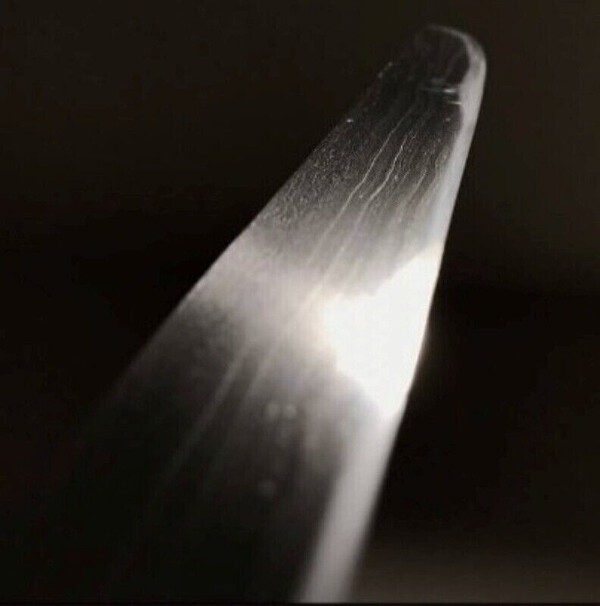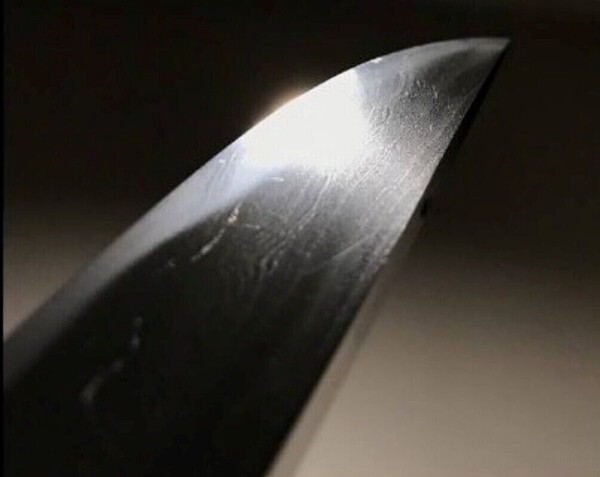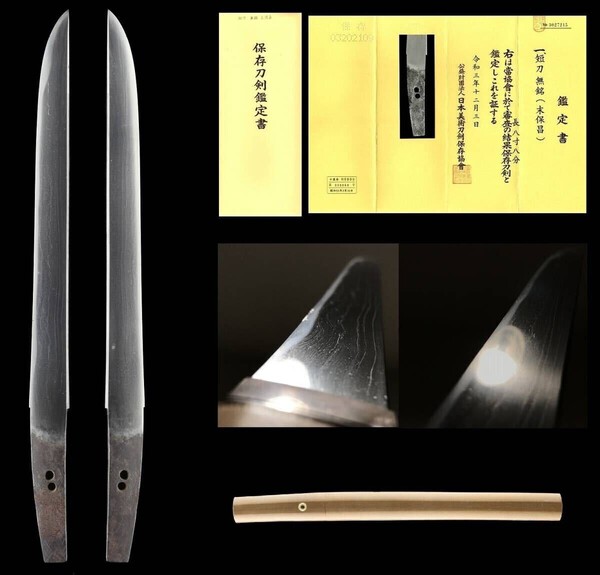-
Posts
95 -
Joined
-
Last visited
-
Days Won
1
Content Type
Profiles
Forums
Events
Store
Downloads
Gallery
Everything posted by jt nesbitt
-

The E-bay snag of a lifetime?
jt nesbitt replied to Jonas Ne's topic in Auctions and Online Sales or Sellers
Jussi is absolutely right. If you are like me, the only way to learn is a combination approach. I can't make a real connection unless I have the THING in my hands and can look at it. Photos and dry texts only take me so far, I have to "feel" it. Read books, AND buy inexpensive stuff. The ebay seller - "hitendo" deals in inexpensive, but honest blades, and is a nice man. It's where I bought my first blade - and I still love that inexpensive but GREAT wakizashi. I would never sell it! Look him up. -- JT -
So...Three and a half years later... I finally found something similar online. I sure would appreciate a full translation of this certificate 'cause I haven't had a good nights sleep since I bought this damn thing! Thanks in advance for your opinions and expert analysis! -- JT
-

What is the best Nihonto Blade you've ever seen in hand
jt nesbitt replied to Tom Darling's topic in Nihonto
Q - "What is the best nihonto blade you've ever seen in hand?" A - The next one. -
Hey Nathan- It's a Great buy because it has led you down a rabbit hole that you wouldn't have otherwise travelled. A great teaching tool, and a beautiful sword as well. I wouldn't worry about chasing down NBTHK, just enjoy it! I have a few of these type of inexpensive and questionable blades that I really love, and I have come up with a formula that has worked out great as a guide for buying them...GET READY FOR THE SECRET TO HAPPINESS with authentic-but-inexpensive Nihonto collecting - THE $300.00 RULE! Nice hada - $300 Nice overall sugata - $300 Nice hamon - $300 Nice habaki - $300 Nice shirasaya - $300 Nice mei - $300 Nice polish - $300 Some kind of papers - $300 Since your sword check All of these boxes - you saved $900!!! A SAGE and SALUBRIOUS purchase! If you want to sell it, I would be happy to give you the $1,500 that you have invested, just DM me! -- JT
-

This is Fake right? signed but
jt nesbitt replied to Johnbull's topic in General Nihonto Related Discussion
Woof. Run Away. Just curious - how does the seller describe this? Would be a great case study for the section on fake nihonto that Brian is assembling here - -

Tips for finding inexpensive nihonto?
jt nesbitt replied to axeman1984's topic in General Nihonto Related Discussion
Justin- Grev is Spot-On. When I first started collecting I bought from Hintendo and had a great experience. He specialized in "nice but not historically significant" type stuff. Subsequently, I tried various other vendors on Ebay and have been let down about half the time. Always had good communication and good product from Hintendo. Your next stop is Amazon to buy this- "The Connoisseur's Book of Japanese Swords" by Kokan Nagayama. Also "Encyclopedia of Japanese Swords" by Markus Sesko Will really help you with deciphering the "code language" that you are going to find here on the NMB. Welcome to the Rabbit Hole. -- JT -

Proper Etiquette and Horimono
jt nesbitt replied to jt nesbitt's topic in General Nihonto Related Discussion
For group consideration on the topic - Here is a Gassan blade made in 1867 with a horimono engraved in 1967... A Shinshinto katana with ato-bori horimono done in "modern" times. I think that it looks amazing. -- JT https://www.aoijapan...iou-3-nen-8-gatsuhi/ -

Wakizashi in koshirae - discussion, and check my notes
jt nesbitt replied to Scogg's topic in Nihonto
Sam- As the most amateur member on this board, and the guy who is always buying old worn out junk then pestering the good people here to waste their time analyzing it for me - please take everything that I am about to post with Extreme Reservation! I love this sword. The second smaller groove that you are seeing below the main bohi is called a soe-bi. Technically the groove pattern that you have is a koshi-bi with soe-bi. You are right to notice that a faint soe-bi is a great indication of polishing. Like the tread of a tire. Yours doesn't look that that bad, compared to others out there, so that tells me that there is thick enough kawagane surface steel (health) left in this blade for a professional polish to be conducted. There are some deep pits in the kissaki and mune that are going to remain, but I suspect that they may be able to be disguised by a good polisher as "ware" - forging flaws and openings that are typically not a deal killer on koto swords. Generally speaking, old swords get a pass when it comes to imperfections like this. Which brings me to the next topic, age. I think that this is a legit OLD sword. My best guess is that this is a seriously chopped katana. Probably a late Muromachi period (1580's) katana. Swords were shortened ALL the time in the old days prior to about the 1620's. In the late Muromachi period, they were making swords that resembled massive Nanbokucho blades, and the general consensus is that what the smiths in the late Muromachi were going for is something that looked liked shortened Nanbokucho stuff - so that you could buy new and not have to cut up an oldie, but still use it in the same way. I have one of those Muromachi blades in my collection (Echizen Kanenori) has a nagasa of 30", so if it had a serious o-surigae down to wakizashi size, you might not see the original mekugi-ana at all, just like what I THINK is shown here. There is a boshi on this one but it looks to my eye like the the kissaki has been re-shaped as it looks a little thinner than the hamon. That would be consistent with chu-kissaki seen on these late Muromachi, Nanboucho-style katana. For some reason, this sword kinda reminds me of my Kanenori with it's elegant sori, nicely done itame hada (not too big, not too fine, just right), and very tastefully executed bohi. I am a firm believer that ALL of these old things have value. If they are well crafted, that means that somebody dedicated a lifetime of learning to make it, and that passion has value to me. Having nihonto experts express admiration, and subsequent papers is a very important component to learning this subject matter, but you have a GREAT learning tool in your hand right now. I hope that you use it. - - - -Books that you should buy right now (heck I had to use these just to be sure my spelling was correct a few times in this dumb post!): - - - "The Connoissur's Book Of Japanese Swords" by Kokan Nagayama "Encyclopedia Of Japanese Swords" by Markus Sesko Congratulations on a great find! Considering the price that you paid - I would definitely send this out for polish....Ya got nothing to loose. -- JT -

Proper Etiquette and Horimono
jt nesbitt replied to jt nesbitt's topic in General Nihonto Related Discussion
Piers- Wow! straight to the source! I am still in the early stages of planning this trip so nothing is set in stone, no steel has been bought. Is "Tumi" of the Osafune Museum some kind of business manager? Is there contact info for a specific facilitator that I could have access to? How do I actually get into this network? Thank You!! --- JT -

Proper Etiquette and Horimono
jt nesbitt replied to jt nesbitt's topic in General Nihonto Related Discussion
All good points and thanks for the participation. I sure would like to find someone on the NMB who has actually commissioned work and could describe the experience, along with some actual contacts within the traditional Japanese craft community. -- JT -

Proper Etiquette and Horimono
jt nesbitt replied to jt nesbitt's topic in General Nihonto Related Discussion
Piers- Thanks for the reply. Looks like you have had interaction with the kind of people that I should reach out to. Do you have any contact info for any of these craftsmen? There must be some sort of business manager who facilitates commissions, and handles sales inquiries right? Thank you. -- JT -

Proper Etiquette and Horimono
jt nesbitt replied to jt nesbitt's topic in General Nihonto Related Discussion
Mark- Perhaps I have misused the term Ato-bori. What I was driving at is that all horimono are applied after forging and polishing, by a specialist. The Marcus Sessko encyclopedia defines the term as "carvings on a sword blade added later". He doesn't specify how much later... Anyway - my question is do you have any experience with traditional Japanese engravers? Can you point me in the right direction? And have you ever enquired about having an old blade engraved, if so, did you get any push-back on the topic? -- JT -

Proper Etiquette and Horimono
jt nesbitt replied to jt nesbitt's topic in General Nihonto Related Discussion
Hey John- Since all horimono (ancient and modern) are done ato-bori, I am going to assume that a large part of the craft is determining how to cut, and where to cut it. Involving the craftsman in initial blade selection would be a good idea I suppose, but I don't have any solid info. Hoping someone here has good intel on this subject. -- JT -

Proper Etiquette and Horimono
jt nesbitt replied to jt nesbitt's topic in General Nihonto Related Discussion
Geraint- I have thought about that a lot. And it might be the route that I take, but the question about the cultural acceptance of applying new horimono to old blades remains. Is it acceptable? -- JT -

Article on Nihonto fakes needed
jt nesbitt replied to Brian's topic in General Nihonto Related Discussion
As the resident garbage collector - I have a great DEEP fake! What has a hada pattern, a shirasaya, a (faint) hamon, was advertised as Edo period on eBay, located in Japan, and has Japanese paperwork -----But is not Nihonto? Hantanrento! Early on in my journey, I got suckered by this one but I didn't pay much for it and it's a great educational tool. I still think that it is a cool thing to have around anyway! -- JT -

Proper Etiquette and Horimono
jt nesbitt replied to jt nesbitt's topic in General Nihonto Related Discussion
Patricius- Yeah, I come up with a lot of dumb ideas, but I guess one could ask "why buy a Gendaito, when there are already so many old swords available?" I think that it could be a tremendous learning experience, or a total dumpster fire. Cool excuse to go to Japan though... Anybody have any experiences like this? -- JT -
Hello again my friends! I had to dip out for awhile as I was finishing up a motorcycle project, but for better or worse- I am back in the game. So here is a question - Is it considered appropriate to apply new horimono to older blades? What I am thinking about is a trip to Japan (my first), with the goal of engaging with a craftsman to apply a bespoke horimono on a Shinshinto wakizashi. The horimono that I have in mind is "period correct" and the wakizashi that I have my eye on is "nice" but not a masterpiece. It does not have some profound and amazing hada that would be ruined by horimono. Would I be coming across as a total jerk for asking this of a traditional artist? Anybody have any idea who could execute the work, and what does this cost? I have seen video of an engraver in the Osafune Sword Village, The Wakizashi is in Tokyo....If I buy a blade in one location, then carry it to somebody else's workshop, could I get in trouble for carrying a concealed weapon? Thanks for any advice, I for sure don't want to fly all the way to Japan only to insult people that I have so much respect for. -- JT
-
Woah- Somebody's got the it bad! 100 pieces! Dang Brah - you really know what you are into! Got any that you want to sell? I really like it too and would like to have an authentic piece. -- JT
-
Yeah Jussi, I was watching that one too... a very interesting hada and reminded me of this junker. Thanks for this translation, it's what I thought it was but I had to be sure. Have you ever seen a Hoju wakizashi? -- JT
-
Hey NMB- JT Nesbitt here to pester you again...I made this post over a year ago about a mysterious wakizashi that I came across - https://www.militaria.co.za/nmb/topic/39660-ayasugi-wakizashi-who-made-this/#comment-410561 This little dude has been eating at me for a year and a half, occupying way too much of my limited mental capacity. Recently I saw a great looking Hoju tachi on Aoi and the hada looked VERY similar to what I am seeing in this Wakizashi, a little more random and "messy" than Gassan. I read that Hoju made Wakizashi, but that they were "rustic". This fits with what I have in hand. In light of this, I would like for someone to please help with an exact translation of this sayagaki. Thank you for your kind attention! -- JT
-
Bruno- You are "polishing" this sword on an electric buffer with a cotton wheel hence "I notice this blade get much more hoter in the polish process". There is a disconnect in what the word "polish" means. In the nihonto world it means something very different than what you are used to. It is in fact NOT about making a surface more homogenous in the way that you would imagine adding luster to a piece of gold. Here's the secret to Japanese steel as opposed to western steel - The way in which it is crafted - the metal itself is never in a liquid state. It is NEVER homogenous. It is worked in a semi-solid state. Even the foundational material - Tamahagane is a semi-solid in it's hottest state. The beauty of the steel is only revealed when the "Togishi" (sword polisher) flattens the roughness of the raw forging in a manner that reveals the layers of steel rather than blending them - the way a buffing wheel will. This is not like modern knifemaking either, where "damascus" steel which is really just different grades of liquified modern steels, are then acid etched to reveal a texture. Traditional Japanese polish uses stones and water. The steel flattened and kept cool always. -- JT
-
Uh - not at all similar. You are implying that the only reason for collecting is to profit from the act of acquiring things. My motivation is to learn more about the subject matter (education). Reading books can only take me so far. I am a visual learner, and going through the exercise of studying, photographing, and asking experts foolish questions is OK with me, as long as it's OK with everybody else. I think that this Piece of Nihonto is very interesting BECAUSE it is so flawed. Kinda like me. -- JT
-
So am I finding a consensus here? - This is Gassan work from the late Muromachi (which has value) That has a forged Mei done long ago (that renders it worthless except for educational purposes). That has a nakago in poor condition, and is polished to death (also rendering it worthless). How very interesting! I think that it was money VERY well spent, and thank you all for your input! I learned a lot! --- JT P.S. The only remaining mystery is - why on earth would a forger include a smith's given name?
-
Dave - In this very cool link that you sent about Chikuzen Jitsua the author of the piece very accurately describes what I am seeing with this hada as "itame mixed with ayasugi and some flowing masame". It also describes it as "rustic" - I would go for that when describing this piece. Is it possible that the "mei" on this blade was done fairly soon after this was made in an attempt to describe this as a Sa blade that was made before Saemon Saburo studied under Masamune and became the "Great Sa"? If that were the case, this would not be a Mei, but rather an attribution that someone added, but I am positive that this signature - whatever it is - was done in period. Is it possible that this is an early "rustic" Chikuzen Sa done while working in the family shop with his father? The shape and length of this blade says Muromachi, but it is very thin, less than .250" (5.9mm) when it was first made. There is no Habaki because the nakago is wider than the blade due to polishing, the first character lives halfway into the polish.....Weird, right? Registered in 1954 3 years after the program began. Sayagaki is consistent with the "signature", yes? For what it's worth- This blade feels very thin and light in hand, almost utilitarian - like a butcher's knife. Thanks to everyone who posted! Any further observations? What have I overlooked here? Love this interaction very much! -- JT
-
I am going to assume that the signature is a forgery, but done a long time ago on a Gassan wakizashi? Does this make sense? I can't find a signature for "Saemon Sabouro Sa" anywhere and it would seem very weird for a forger to include a smiths given name...why not just forge "Sa"? less likely to attract suspicion, right? I would be very grateful if someone would please translate the registration card copy, mainly to know when this thing was registered. THANK YOU so much, Y'all! -- JT







